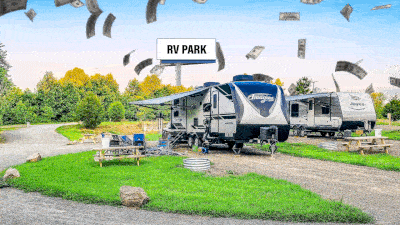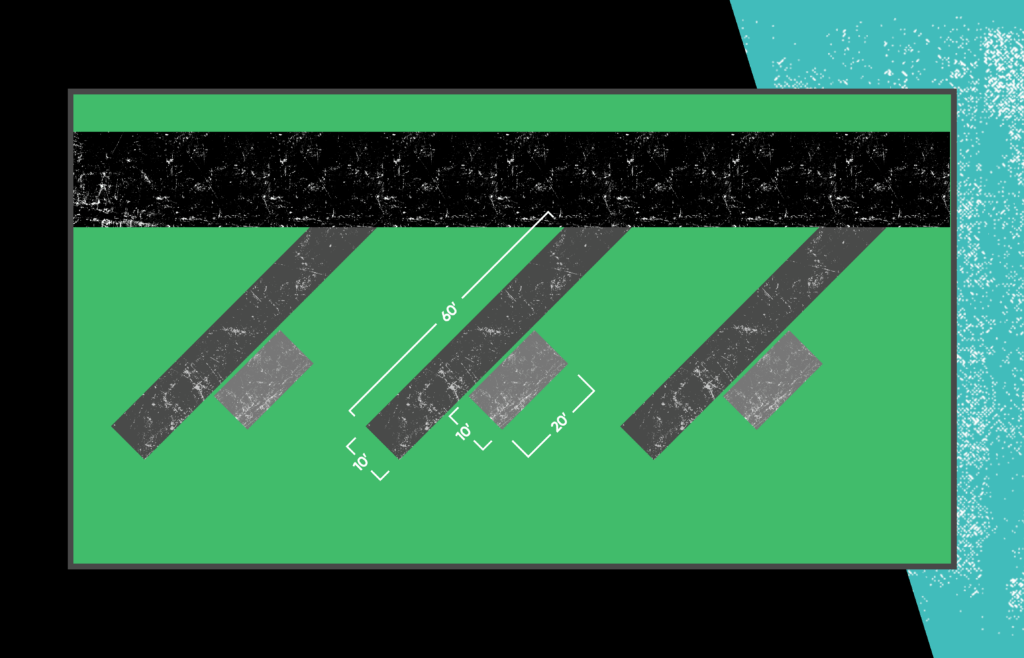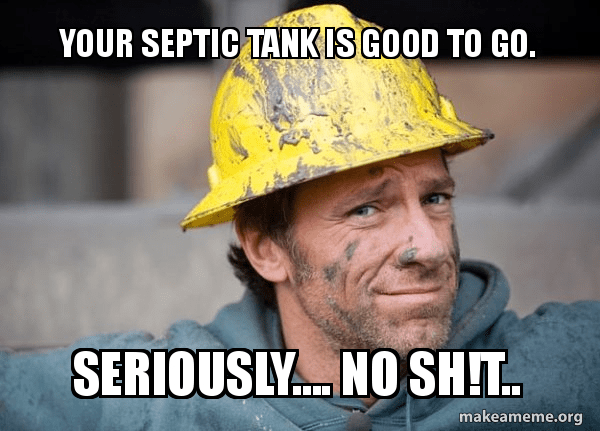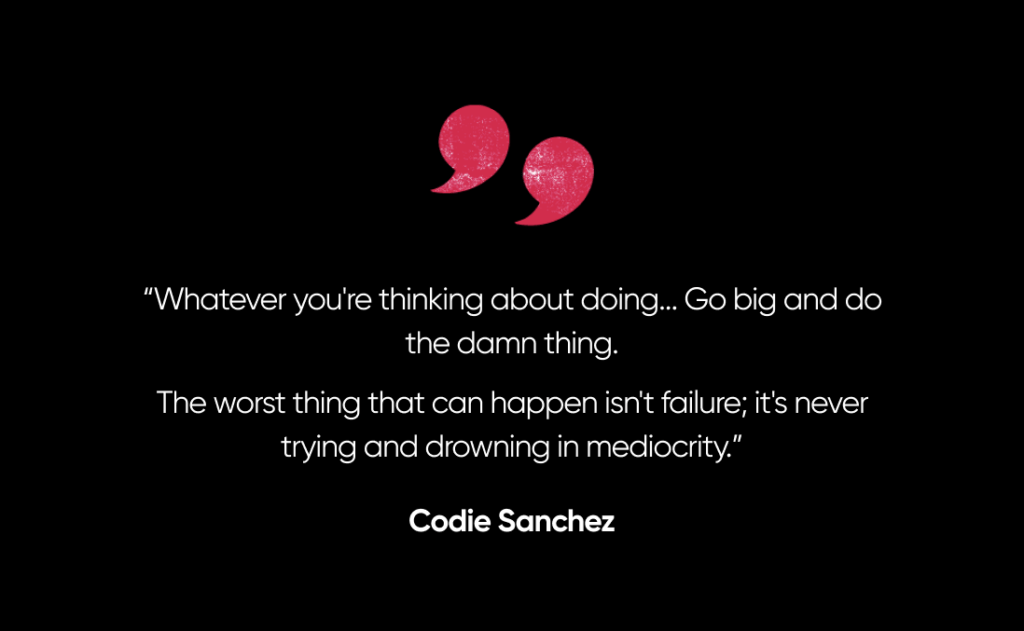
Over 9.6 million households plan to buy an RV in the next few years, with many of them intending to spend at least 25 days per year traveling in it. Over 11 million people already own RVs, too, making this a really hot business market.
At least half of Americans want to travel more.
The digital nomad movement grew by 131% since 2019.
People are anxious to get the hell out of dodge and go on adventures.
If you own an RV park, you can tap into all these trends at once.
Start an RV park and hire someone else to manage it? Even better. Get recurring revenue with a proven business model.
Here’s everything you need to know about starting your own RV park and why buying an existing one is a better choice than developing from scratch.
Find Potential Locations and Acquire Land
When it comes to real estate, you already know it’s all about “location, location, location.”
Your park should offer enough amenities to make it attractive on its own. But should be within driving distance to some other destination, like a national park.
Expect to pay around $3,000 per acre when acquiring land for a campground RV park. Great land in attractive areas may be even more expensive.
Factor in that you’ll also spend at least $15,000 per site, and you’re looking at a hefty upfront cost for a custom RV park build.
When scoping land, you can research it yourself or work with a real estate agent. You may find that a realtor knows more opportunities than what you can find in your own research.
Agents may be more familiar with finding all possible options based on location, property type, zoning, and your price range. This can speed up your research significantly.
If you can find a land agent as opposed to a residential realtor, they may come with more experience resolving complex land issues like encroachment, title defects, mineral rights, or survey problems.
The biggest benefit to buying land without a realtor is cost savings. You will still have to pay closing costs, title search fees, and title insurance but will avoid paying the realtor’s fee.
Land for sale may be the right size. But it might come with limitations that affect your budget and launch timeline.
For example, if you need to clear a lot of trees or run electrical or water to an undeveloped area, that can be a big investment of time and money.
Here are some important things to keep in mind as you narrow down possible land sites:
- The outdoors is a common theme, so look for somewhere people would enjoy relaxing (loud highway nearby? Not a good choice)
- Do you have enough space on the land plot to allow for other infrastructure like walkways?
- Is the location a place people want to visit standalone or somewhere they pass on popular road trips?
- Is the land in a high-crime area?
- Is the area at risk for flooding?
- Do you have existing access to the land from public roads, or will you have to build roads?
- Do you need a well on the land?
- Will you get mineral or other rights with the land?
- Will you receive fire protection within the jurisdiction?
- Do you need insurance on the land?
You need to learn as much as possible about your intended land to protect yourself from costly issues.
Knowing what will help make your park interesting for RV travelers can help keep your bookings up once you build.
Design Your RV Park and Plan Infrastructure
An RV park is so much more than a slate of places for people to park their vehicles.
You need an infrastructure layout developed in advance, including space for plenty of things like:
- Roadways
- Walkways/trails
- Parking for cars
- Registration office
- Shower/bathroom facilities
- General store
Buying the right size land ensures you have plenty of space for everything you need, but also that you have a good layout that works well for visitors.
Flow is key. If you have to place your shower area a long walk from the RV sites, you might lose customers or hear complaints. Try to think logically about providing room between louder, highly-trafficked areas and the parked RV locations where people sleep.
(Pro tip: the number one way to piss off your RVers is to put campsites too close together. No one wants to hear their neighbor’s toilet flush or the couple next door’s argument while barbecuing.)

The Society for Outdoor Recreation Professionals recommends sites with a minimum of 60′ x10′ space next to a 10′ x 20′ patio. If you have the space, include a gravel area for parking one car.
If you’re offering full hookups, you’ll also need to run 20/30/50 amp electric, water, and sewer to the site. You’ll also need a way to run these elements to any common areas like pools, bathrooms, or your general office.
Don’t forget basics like a road or driveway, which comes with its own difficulties. Excavating and paving are expensive, and fill dirt/drainage control problems may also occur.
Make Sure Your Plan Complies with Legal Requirements
Finding the perfect piece of land could be a red herring.
Before you start building an offer to buy the land, look into local zoning laws that affect whether you can build an RV park there at all.
Each state has its own definition of RV park, too. Most locations will require obtaining a recreational zoning permit, a commercial zoning permit, or both.
Lawyer up! Find a local real estate lawyer to confirm what you find.
If you purchase land zoned as residential or agricultural, you’ll need to get it rezoned. That can be a lengthy and challenging process, especially if you don’t currently live in the same area as your intended RV park.
Local and state governments may require you to get an array of licenses and permits. A delay in any part of this process can significantly extend your launch day timeline.
If you buy an existing RV park instead of starting a new one, you may still need some permits and licenses for building or running new electrical or plumbing. But unless you’re inheriting an ancient septic tank or have to completely rebuild sections of the park, it should still be much faster than building from scratch.
Secure Financing for Your RV Park
You can use your own savings to get started, but because of the substantial capital needed to set your park up, you likely also need a business loan. You may also need a land loan to secure the initial location for the park.
Some RV experts say you should plan to spend at least one-third to one-half of what you spend on land just for development costs.
With outside financing, you need a solid business plan. You’ll need to explain why you think the market will help deliver returns for you to repay the loan. This requires acknowledging how long you think it will take you to build the park.
Conduct a feasibility study in advance and identify other parks with similar parameters that may be good comparisons to the potential for yours.
It’s much easier to show what an existing RV park already brings in. You can supplement that with how any improvements you make will boost revenue.

With an existing RV park, you may be able to remodel sections of it or reopen after construction much faster. This might make getting a loan much easier since the operation is already viable or nearly viable from day one.
Organize the Building and Construction Process
A brand-new RV park requires finding and hiring the right construction team. Depending on their experience, availability, and pricing, you may need to work with multiple contractors to complete all the legwork to open an RV park.
The construction process will vary in terms of time and budget needed based on whether you’re aiming for a five-star experience or more of a self-serve environment. Materials and labor will also cost much more if you’re trying to add more spots for RVs.
Look for contractors who have experience in commercial work, especially if they have a background in other RV parks or campgrounds. This makes the work much easier when the construction team already knows the materials, permits, and timelines.
As you build, consider the following:
- Investments that serve your early needs but also enable growth
- The space you’ll place between each RV station
- How delays in one area of construction may influence the rest of your schedule
- Whether you need a separate location for short-term and long-term RV visitors
Construction is the most complicated aspect for many new RV park owners, and it often comes with the most headaches and setbacks, too.
You can bypass a lot of these challenges by buying an existing park.
Don’t Forget Your Septic
In addition to things like an office, parking lots, and shower facilities, you’ll also need to consider a major investment for any new RV park.
Most people overlook the basics—like septic tanks. But the reality is they can be a huge pain for new park owners.
You need to be prepared for things like your land failing a soil test or if you want to build somewhere where you must install a more expensive or environmentally friendly system.
The septic system requires additional space for a leach field and may be one of the largest investments you make in turning a piece of land into a suitable park.
Environmental testing is also required before building and installing a septic tank. Involved government agencies (typically the Department of Health and Human Services) will make recommendations based on the size of your park and your overall location.
Your state’s guidelines may also require tests for:
- Soil compaction
- Organic materials/contamination risks
- Groundwater analysis
- Seismic issues
- Foundation design
These tests can be expensive and time-consuming. Your test results may limit what kind of septic you can install. You may wind up having to accommodate a variety of factors that could all impact your budget.

If you purchase an existing RV park, your septic will likely already be set up. You can avoid this headache as well. Get it inspected so you don’t end up in a world of shit later.
Market Your RV Park
Once you obtain the land, get the permits, and rebuild, you still need to consider a comprehensive marketing strategy for your RV park.
Here are some of the best ways to get the word out there quickly and effectively:
- Create an SEO-optimized website
- Capitalize on reviews from customers across your online presence
- Submit your data to online directories for camping and RV sites
- Partner with RV dealerships in the area
- Run ads on social media
- Attend travel events and trade shows
- Participate in regional community events
Here’s another place where an existing park has an edge: it already has a reputation and customer base.
You can benefit from the reputation the previous owner built up from day one. Their reviews and revenue should back this up during the buying process.
Manage and Grow Your RV Park
Day-to-day management of an RV park can be overwhelming. But if you purchase an existing park and upgrade quickly, you may be able to hand it over to someone else.
Another person onsite can make it easier for you to manage big-picture marketing and operations strategy.
Continue to invest in the park’s maintenance and upgrades. Stay competitive by listening to feedback from current campers and implementing changes to keep your park appealing.
You may even choose to brand your RV parks and purchase multiple locations. This helps cement common amenities for people who travel in RVs, making your parks a top choice for short and long-term stays.
An existing park may even come with an operator and staff already in place!
Why Buying an Existing RV Park is Better
Now that you know the steps involved in building your own RV park, it might feel overwhelming or as though your dream of hosting guests is well off in the distance.
There’s some good news: you can shortcut a lot of these processes by buying and improving a current RV park.
Buying an existing RV park is often a far better choice than building from scratch for these reasons:
- You can use current numbers to accurately predict demand
- You can maximize your budget by improving a little at a time
- You can avoid a lot of delays involved in licensing, permits, or new construction
- You can build on the existing infrastructure by making improvements at lower cost
- You can start making your investment back much more quickly
- You can use an onsite operator to optimize things rather than create them entirely
- You may be more likely to get financing with a site that already makes money
- You won’t need to spend as much time onsite to launch, giving you more freedom
If you have the choice, try to find an existing RV park with strong potential for more customers after some tweaks. Look for ways you could expand revenue after taking over, like expanding with more lots or adding new amenities.
Still on the fence about buying over building? Check this video out to see how one RV park owner turned a $47K down payment into a 283% cash on cash return.
The immediate returns from buying a park outweigh the lead time of building.
To get those creative juices flowing, here are some value-adds you could put into a current RV park that make it desirable for visitors and profitable for you:
- A camp store
- Paved campsites
- Pool/hot tubs
- Adults-only pool hours or camp zones
- Garbage pickup
- Dog park
- Credit/debit card-operated laundry center
- Pet daycare
- WiFi
- Cable TV
- Fishing lake or pond (bonus points for renting kayaks or paddleboards)
If you’re feeling inspired to buy an RV park, check out marketplaces like BizScout, BizBuySell, or Campground Marketplace to see what’s out there.
Note: We own BizScout. We created it to make searching for and buying businesses like RV parks easier for people.
Take Action to Own an RV Park Today

Building your own RV park sounds like a dream, but it might turn out to be a nightmare. The cost, time, and frustration of managing all these projects at once can prove difficult.
But by buying an existing park instead, you’re making a better business decision and providing for faster cash flow.
Look at all the pros and cons of building vs. buying and make a decision based on your own entrepreneurial dreams. Then start researching all the steps listed above.




